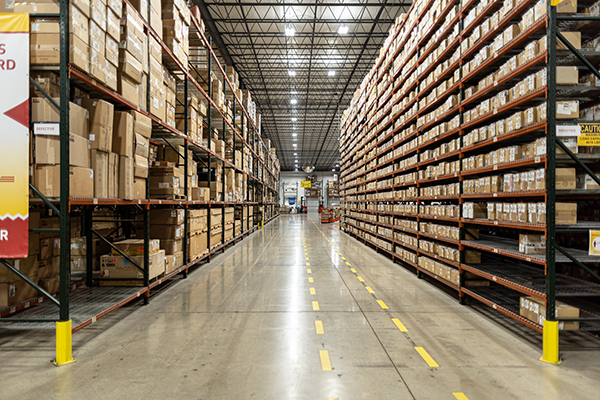Connected lighting offers the potential to improve facility operations and sustainability and support worker health and safety.
By John Bouls, End-User Marketing Leader, Office, Healthcare & Industry, Signify
As we continue to grapple with supply chain challenges, it’s never been more important to ensure your manufacturing facility is running as smoothly and efficiently as possible. Did you know that your site’s lighting can play an important role here?
Lighting technology has evolved dramatically, delivering so much more than simple on/off illumination. When connected to sensors and cloud-based software, or the Internet of Things (IoT), lighting has the potential to optimize facility operations, support worker health and safety, and improve the sustainability of industrial spaces.
Here are a few ways in which you can unlock this value for your manufacturing or industrial facility and drive a brighter future of your business.
Are you aware of when your lighting fixtures or building assets are due for maintenance? Connected lighting systems can empower you to break out of being in reactive mode and benefit from a predictive approach. The technology can collect diagnostic information, such as how long lighting has been operating, remind managers when scheduled replacement terms are approaching and even help identify environmental threats like humidity and temperature in shop floors. Equipped with these insights, you can not only ensure that your lighting is working at its best, but also enable consistent uptime in your facility and avoid potential (and costly) problems before they occur.
Connected lighting technology can also arm you with the “smarts” to:
You can get a richer picture of your facility and make more informed decisions about your day-to-day operations. Just think of the difference this improvement could make to your business.
Industrial settings present unique challenges for keeping workers secure, productive and comfortable. Proper illumination is obviously critical – but with connected lighting, you can go a step further in supporting these special circumstances.
As previously mentioned, lighting can be tailored to support different tasks across your site. When integrated into a connected lighting system, fixtures can be controlled individually, so individual employees can get the right setting they need. The lighting’s color temperature and intensity level can be adjusted to help increase worker focus or alertness, or foster a natural circadian rhythm, or body clock, in line with a worker’s shift.
Do you have physical distancing measures in place at your site? Leveraging the sensors embedded in your lighting fixtures, a connected lighting system can also be tapped to support your COVID-19 protocols. Employees can check via an app on their phone or mobile device if a certain space is crowded, or if they should take a less busy route to navigate your facility, especially during high traffic periods, like closing or opening shifts. Even better, it can be equipped with a people-counting technology to implement 50% occupancy quota, and increase or decrease that percentage tracking as needed by organizational policies or legislative measures.
Similarly, connected lighting can track the location of physical assets, like automatically guided vehicles or forklifts, in support of workplace safety goals. The sensors could detect when workers stray too close to potentially hazardous equipment, for example, and cue lighting changes to alert the worker and even disable those assets.
By connecting something you already own – your lighting – you can introduce new protocols like these that reinforce your commitment to creating a workplace that supports employee health, safety and wellbeing.

Energy efficiency is no easy feat in the industrial sector, which accounted for 33% of total U.S. energy consumption in 2020, and especially for manufacturing, which accounted for more than three-quarters (77%) of that percentage, according to US Energy Information Administration projections.
A connected lighting system can go a long way towards helping you comply with regulatory standards and meeting your sustainability objectives. You can reap energy savings not just from making the switch to LED lighting, but also from having the ability to monitor and manage your facility’s (or even several sites’) consumption. You can use the energy reporting in combination with other sensor-based data, such as presence detection and shift patterns, to identify reduction opportunities: Are you lighting areas that aren’t in use? Over lighting your facility at night when only security is present? And it doesn’t stop there – you are in full control; you can customize your lighting behavior at any time to suit your operational needs.
DHL Supply Chain reported that one of its buildings is consuming approximately 53% less energy – exceeding its goal of saving one million kilowatt hours annually – after installing a connected lighting system. Research has even shown that savings can reach up to 85% when all facility systems, including LED lighting, sensors and HVAC, are combined.
Connected lighting provides a platform for innovation within manufacturing and industrial settings. The technology can be applied to fulfill many business imperatives, whether that’s improving your operational efficiency and effectiveness, facilitating employee health and safety efforts, and maximizing energy savings. Above all, it stands to transform your facility into a state-of-the-art environment that will illuminate the path to better results and a brighter future.

John Bouls is End-User Marketing Leader, Office, Healthcare & Industry at Signify.
In this episode, I sat down with Beejan Giga, Director | Partner and Caleb Emerson, Senior Results Manager at Carpedia International. We discussed the insights behind their recent Industry Today article, “Thinking Three Moves Ahead” and together we explored how manufacturers can plan more strategically, align with their suppliers, and build the operational discipline needed to support intentional, sustainable growth. It was a conversation packed with practical perspectives on navigating a fast-changing industry landscape.